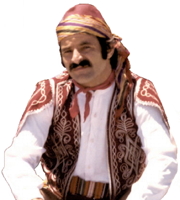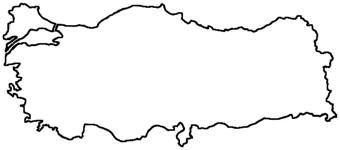
|
The Society of Folk Dance Historians (SFDH)
Turkish Folk Dance Origins
[
Home |
About |
Encyclopedia | CLICK AN IMAGE TO ENLARGE |

|
 Today's "Modern Turkey" has a history of only fifty-six years (from 1979), but Turks have a culture, taking its roots from Central Asia from where they hailed. They blended the rich culture that they brought with them, strongly resembling a cross between Central-Asiatic and Chinese cultures with the rich cultural remnants of the previous cultures in Asia Minor, which the Turks call Anadolu (motherland) today.
Today's "Modern Turkey" has a history of only fifty-six years (from 1979), but Turks have a culture, taking its roots from Central Asia from where they hailed. They blended the rich culture that they brought with them, strongly resembling a cross between Central-Asiatic and Chinese cultures with the rich cultural remnants of the previous cultures in Asia Minor, which the Turks call Anadolu (motherland) today.
Asia Minor is an ancient land with many civilizations establishing domains and empires upon its ground. The earliest and major of the empires were those of the Hittites, Greeks, Phrygians, Lydians, Romans, Armenians, Assyrians, Cappadocians, Byzantines, Seljuk Turks, Ottoman Turks, and now, modern Turkey. Cultivation of wheat and barley first occurred in this fertile land and the first animals were domesticated here. Regional cultures, traditions, and dialects all developed on this land as civilization after civilization coursed through history, leaving its marks. These cultures all blended into one Turkish culture as we see it today.
Turkish folk dancing is a direct derivative of the religious ceremonial events performed and conducted by the shaman (priest or medicine man) of ancient Central and Western Asiatic Turks, millennia before 900 CE when Turks accepted the Moslem faith en masse. In his dancing, the shaman was exorcising and/or chasing the evil spirits away as well as dancing to obtain divine powers and an understanding of the supernatural. The rhythmic movements and grace of his dancing gave strength to the individual.
To these ancient Turkish tribes of Asia, whose religious foundations were Shamanism and Buddhism (Webster's Dictionary definition of shamanism: a primitive religion of Central and Northeast Asia holding that gods, ancestral spirits, etc. work for the good or ill of mankind through the medium of shamans), the skies always represented the heavens (God), the supernatural, and the unknown, and were represented by the color blue. The earth, the known, the natural, and the environment, was represented by a red-brown ochre color, as one can observe in ancient reliefs existing in China today where they describe the shamans of the neighboring Turkic tribes against whom the Great Wall of China was built. The Chinese described these shamans as "man gracefully dancing in long sleeves1 . . . and waving scarves of blue color as they danced and played the drum." The shamans always danced and contacted with the sky-God "Tengri" (current Turkish word for God is "Tanrı") through the medium of the Davul (a big drum played with a wooden club on one side and a reed on the other). The shaman would "dance" particular rhythmic movements to gather forces to expel the unknown, to reach an acceptance of ill-fate, or to expel evil forces threatening the individual or community. Sometimes, for example, two shamans would dance together with the drums to invoke the supernatural in eliciting fertility in man as well as animal.
Today, when we ask the Turkish peasant why he dances, the answer is "for custom's sake," "for good crops and a good harvest," and "for recreation."
These shamanistic rituals, done and carried over and over through the millennia have been, by far, the most important factor in shaping the two thousand or so folk dances found in the Anatolian peninsula where modern Turkey lies today. There are six factors to look for in observing Turkish dance:
- Asiatic-Shamanistic influence,
- Previous Anatolian cultures leaving their mark in Asia Minor,
- Islam religious influence,
- Immigration of other peoples to live and mix with the Turks,
- Expansion of the Turks as the Ottoman Empire into Asia, Europe, and Africa, and making contact with other cultures, but remaining the dominant figure,
- Westernization of the Turks.
We have seen the spiritualism of dance with the shaman. Later, Islam having followed in general, a negative effect on the dancing tradition of the Turks. Islam's puritanical interpretation of dance ruled that dance was governed by "bad spirits" and hence, outlawed the ritual dance. These traditions, however, originated by the shamans did not die completely among the newly Muslim Turkic tribes, and as they settled in towns and villages. They kept their dance customs alive, as well as being Muslim in faith. In the villages, particularly, these dances continued to be done, especially during religious holidays, marriage ceremonies, and traditional celebrations of circumcision and harvest. Many travelers have often described dance traditions of these Turkish tribes of the 10th, 11th, and 12th centures and on.
In the 14th and 15th centuries, these Turkish tribes, consolidated now from peoples east and west, united under the Ottoman Empire, and expanded into three continents as conquerors. They brought with them a culture blended of shamanistic rituals with the cultural traditions of the five major cultures that had inhabited Anatolia and the Near East the previous one thousand years before the Turks arrived. The rich cultural blend was made even richer after the exchange of culture and traditions of those conquered peoples and lands, each influencing the other with new words, foods, and traditions. This was a two-way street and the expansion, together with deflation of the Empire, has made Turkish culture and others much richer.
As the Ottoman Empire grew, it became a major power in the world during the 15th, 16th, and 17th centuries. Many more people immigrated to Anatolia, such as the Sephardic Jews, guarded by the Turks from the Spanish Inquisition, and the Circassians running from the Czar of Russia, and all the while other Turkic tribes continued immigrating west. These influxes of people constantly added new elements to blend with the existing folk culture.
As one can see, Turkish dance is a derivative of many sources blending into one. Though losing their initial meaning, the primitive traditions of dance lived on. From the days of the shaman, dance form was cemented and only flourished with the cultural migrations through the Anatolian peninsula, the ever-present throughway between Europe and Asia. Turkish dance remains a subtle blend of ancient tradition as seed to the endles embellishments of cultural history and exchange. The dance is still very much alive in the hearts and feet of the Turk.
REFERENCE
1 And, Metin. Pictorial History of Turkish Dancing. Ankara: Dost Yaninlari, 1976.
DOCUMENTS
- Bora Özkök, an article.
- Dancing in Turkey, an article.
- Turkey, a country.
- Turkish Folk Dance, an article.
- Turkish History Through Folk Dance, an article.
Used with permission of the author.
Printed in Folk Dance Scene, April 1979.
This page © 2018 by Ron Houston.
Please do not copy any part of this page without including this copyright notice.
Please do not copy small portions out of context.
Please do not copy large portions without permission from Ron Houston.